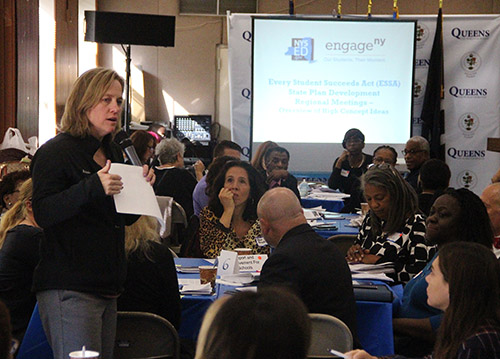Photo Courtesy of the Borough President’s Office
Borough President Katz has said that she supports the new federal education law.
By Michael V. Cusenza
Teachers, school administrators, elected officials, Community Education Council members, community board members, and other stakeholders recently attended a meeting to discuss how the new federal Every Student Succeeds Act can best be implemented in New York.
Borough President Melinda Katz addressed the Nov. 1 conference and indicated that she supports the law that gives states more flexibility in formulating educational policy than they had under the old federal No Child Left Behind Act.
The bipartisan Every Student Succeeds Act was signed by President Barack Obama on Dec. 10, 2015. The measure, according to the Obama administration, reauthorizes the 50-year-old Elementary and Secondary Education Act (the United States’ national education law) and “builds on key areas of progress in recent years.”
The ESEA was signed into law in 1965 by President Lyndon Johnson, who believed that “full educational opportunity” should be “our first national goal.”ESEA offered new grants to districts serving low-income students, federal grants for textbooks and library books, funding for special education centers, and scholarships for low-income college students. Additionally, the law provided federal grants to state educational agencies to improve the quality of elementary and secondary education.
The previous version of ESSA – No Child Left Behind – was enacted in 2002 and represented “a significant step” forward for our nation’s children in many respects, Obama noted, particularly as it shined a light on where students were making progress and where they needed additional support, regardless of race, income, ZIP code, disability, home language, or background. The law was scheduled for revision in 2007, and, over time, NCLB’s prescriptive requirements became increasingly unworkable for schools and educators.
In 2010, the administration said it set out to create a better law that focused on fully preparing all students for success in college and careers.
“With this bill, we reaffirm that fundamentally American ideal—that every child, regardless of race, income, background, the ZIP code where they live, deserves the chance to make of their lives what they will,” Obama said.
ESSA Highlights
According to the administration, the law:
- Advances equity by upholding critical protections for America’s disadvantaged and high-need students.
- Requires—for the first time—that all students in America be taught to high academic standards that will prepare them to succeed in college and careers.
- Ensures that vital information is provided to educators, families, students, and communities through annual statewide assessments that measure students’ progress toward those high standards.
- Helps to support and grow local innovations—including evidence-based and place-based interventions developed by local leaders and educators—consistent with our Investing in Innovation and Promise Neighborhoods
- Sustains and expands this administration’s historic investments in increasing access to high-quality preschool.
- Maintains an expectation that there will be accountability and action to effect positive change in our lowest-performing schools, where groups of students are not making progress, and where graduation rates are low over extended periods of time.
The U.S. Department of Education is now working with states and districts to begin implementing the ESSA.

